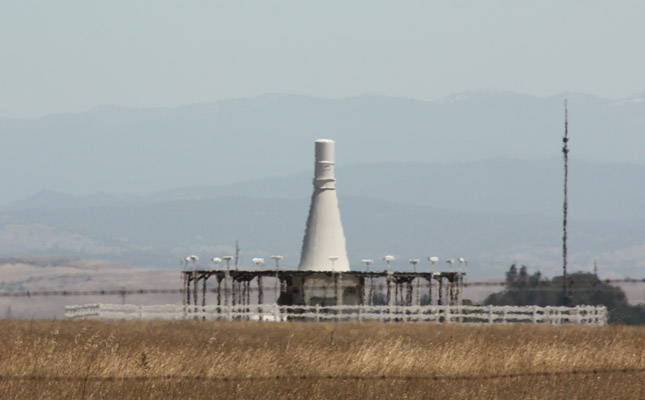At 1 p.m. President Jim Erickson called to order the meeting of the Madera Irrigation District Board of Directors. Four directors and staff were present at the District offices in Madera, while Director Dave Loquaci and about a dozen members of the public were on Zoom. There was no public comment on the closed session and the agenda was approved which identified conferences with legal counsel on two items of anticipated litigation and four items of existing litigation. Conflicts of interest were noted for Directors Brian Davis and Carl Janzen, each for one item. A performance evaluation was also to be done for Assistant General Manager Dina Nolan. The closed session began at 1:03 p.m.
About as scheduled, the Board moved to open session at 2:05 p.m. with the call to order and the Pledge. There was no report from the closed session. For the open meeting agenda, there were no conflicts of interest nor public comment, and it was approved.
Equalization
The Board immediately convened as Board of Equalization to hear and determine objections to the valuation, acreage or any other matter pertaining to assessments. Assistant GM Nolan presented this information which was also included in the Board meeting packet.
The material included extensive documents itemizing all the details of parcels and assessments, as required by law. This roll provides the total assessed value of properties within the Madera Irrigation District boundaries for city, city ag, and rural parcels and is used as a base for computation of the ad valorem assessment rate for the assessment year. Besides the assessments that are collected annually, the District collects other revenues in the form of crop water tolls, standby fees, and other miscellaneous charges that are allocated in addition to those assessments toward District expenditures such as Transmission and Distribution, General and Administrative, Interest, and Source of Supply expenses. The approximate assessment revenue based on the un-equalized roll for 2023 is $6,267,523.76.
As part of the Board of Equalization process, parcels are updated when new parcel maps are received from the County of Madera. These changes could consist of lot line adjustments, parcel splits, category changes and subdivision changes. Those changes are shown in an additional exhibit in the Board packet, Listing of Individual Parcel Changes. Another document identifies those parcels partaking in the District’s Non-Irrigated Lands Program. And still another provides the current definitions of the District categories. The final item is informational as it shows the assessment rates for the period 2013 through 2023 and the average increase each year.
Due to the passage of Proposition 218 in 1996, the District cannot increase the original assessment rate without the majority vote of the District landowners. With the passage of the rural landowner majority vote on March 15, 2011, for bonding of the 9d capital repayment obligation with the United States Bureau of Reclamation, the District was allowed to increase the 9d benefit assessment by 3% per year for a period of 10 years. The final 3% increase occurred in 2021 for the 2022 assessments.
Therefore, the following rates will be voted on by the Board at a special meeting to be held June 17 as follows:
-Original Assessment Rate for City: $ .449769 per $100 assessed valuation
-Original Assessment Rate for Rural: $ 9.436830 per $100 assessed valuation
-9d Benefit Assessment Rate for Rural: $16.683692 per $100 assessed valuation
Director Janzen commented, “We are now 41 years into using an outdated assessment schedule. How many are willing to sell their farmland for $600 per acre? It’s sort of ridiculous.” There were no other questions or comments from the Board or the public. So, the Equalization meeting was adjourned, and the GSA Board meeting was opened.
SGMA
Also presenting here was Ms. Nolan who first praised Operations and Maintenance Manager Charles Contreras and his staff for completing the recharge basin on the 70-acre property purchased recently by the District. She said the MID GSA has been working cooperatively with other GSAs in the subbasin. She said she expected a report soon from the NRCS identifying funding for owners who had applied for land retirement with incentive financing from MID. She commented on the letter in the Board packet from the State Department of Water Resources to Root Creek Water District for $7.6 million of Round 1 grant funding for SGMA implementation. MID and a number of other GSAs had worked together to submit requests with Root Creek as the coordinating entity, all of which will share in this amount.
Nolan also referenced at draft flyer prepared for rural property owners in the District encouraging them to plan for retaining surface water in wet years by maintaining ponding basins and other flood control facilities. Titled “Consider Before You Convert,” the piece emphasized that capturing surface water is crucial to groundwater recharge. When individuals do it, it can help control District costs, thereby potentially reducing assessments. No edits were suggested, and the flyer will be widely distributed. With that, the GSA Board adjourned, and the MID Board reconvened at 2:25 p.m.
The Board
Approved unanimously was the consent agenda which included minutes of the April 19 meeting, the warrant list of bill payments totaling $2,513,812.39, the acceptance of the March and April financial statements, and the authorization for remote Zoom meetings. Included also was discussion and action on two items of District personnel policies regarding family and medical leave and employee performance reviews, aligning them with recent changes in state law.
Controller Jennifer Furstenburg was not in attendance, so the written report of the Finance Department was referenced in the Board packet. HR Administrator Tanesha Welch added a bit of background on the detail of the personnel policy changes as documented in the Board packet. She noted that the term “probationary employment” is being removed and instead the performance of newly hired employees will be reviewed after six months of hire and again at the end of the first year. This is consistent with today’s best practices and recommendations from the insurance carrier. Welch also reviewed other activities in her department which included company-wide training on the heat illness prevention program. She noted that such general meetings provide a positive opportunity for employees and staff to communicate about a wide range of issues.
Always a meeting highlight is the presentation of the monthly update from Operations and Maintenance Manager Charles Contreras. The Board packet included his 10-page report with many photos of work in progress, and he presented further detail and discussion. Several Directors commented positively on projects in their Districts and overall, the Board expressed satisfaction with the amount and quality of work done on the District’s extensive infrastructure.
GM Report
In his report, General Manager Thomas Greci noted that the July Board meeting is cancelled. He said he’s attending a leadership conference next week, as well. He said that assistance had been provided to the city of Madera on several projects. He reported the lease of grazing lands on District Ranch property had been renewed for five more years with the Fagundes family. He said that the current rash of catalytic converter thefts had struck the District equipment yard. The recently installed cameras and alarm alerted the staff at 2 a.m. of an intruder one night. Police officers arrived in five minutes to apprehend the would-be thief.
Greci continued with the major item of new business, discussion and a decision on crop water deliveries and pricing. The amount of water available and its pricing affects not only the grower customers of the District, but it also has big implications for the District budget. He began by saying that for some time, the Bureau of Reclamation had been indicating that only 15 percent of the full allocation would be available to the District from Millerton Lake. More recently, he said there had been conversations about increasing the amount to 20, 30 or even 35 percent. While the staff hopes that there may be 30 percent, the final decision was to plan for and budget a 25 percent allocation of Class 1 water, using that amount to set rates.
Deliveries & Rates
Regarding the timing of deliveries, he said if the system is filled starting June 27, water can be delivered to growers beginning July 1 continuing for the month, even into August depending on availability and demand. All this is similar to last year’s water schedule, he said, but what has changed is the expense side. Not only are District costs higher but the District has to be prepared for a “true up” billing from the Bureau which has to recover its costs on smaller amounts of water delivered.
Greci said that he and the staff have been scouring the budget to look for areas of expense reduction. He said they’ve found about $1 million of cuts that could help keep water rates in line. The capital budget will be cut with no new trucks purchased… it was noted that even if money was there, new trucks aren’t available for delivery anyway. He said the District will hold back on additional land purchases and slow down replacement of some pipelines.
These are the “educated guesses” of staff he said, and the recommended rate for district lands water and operational management water is $225 per acre foot, compared with $200 last year. Water for subordinate lands will be $1,325 / AF. Conveyance fees for lands within the District will be $70 / AF plus 15 percent losses and for lands outside $180 plus 15 percent. After brief discussion in which the Directors agreed this was the best approach to provide for their growers and still be financially responsible for the District. With no further discussion from the Directors or the public, the rates were approved unanimously at 3:04 p.m. on a motion by Carl Janzen and a second by Brian Davis.
In a news release issued the evening of the meeting, the District announced the rates and encouraged land owners to immediately submit crop water applications. Customers are encouraged to stop at the office or go to the website… www.madera-id.org.
President Erickson was quoted saying, “MID is happy to be able to provide surface water to its landowners in this exceptionally dry year. The District has been working tirelessly at piecing together supplies for the benefit of its growers and hopes to be able to deliver through at least the beginning of August.”
This schedule coincides with that of the neighboring Chowchilla Water District, approved at their Board meeting on June 8. General Manager Brandon Tomlinson said the rate for Class 1 water was set at $200 / AF with a 10 to 14-day run beginning July 1st.
Paleo Valleys
A final item of new business was a presentation by Professor Graham Fogg of UC Davis who attended the meeting in person. He said he and his students have been studying groundwater for water 40 years, and he continues even with his emeritus status. His topic here was groundwater recharge as it relates to geological formations under the San Joaquin Valley and the Sierra foothills which he called “paleo valleys.” He noted the renewed interest in recharge, especially in capturing flood waters in wet years. He said that while it’s necessary to be aware of soil types for recharge facilities, what’s below the surface is much more important.
He said that 97 percent of all fresh water in the world is in groundwater. He said that here in California historically, the Sierra snowpack has provided annually 17 million AF of water and reservoirs can store up to 42 million AF. But the subsurface under the Central Valley has room for another 140 million AF, some of the largest aquifer systems in North America. He said “paleo valleys” are big, but complicated… like most everything about California water, this reporter notes.
These paleo valleys are created by the unique geology of the region. Sequential ice ages in effect created underground riverbeds that today provide the best opportunity to store large amounts of recharge water most efficiently. He used the analogy of human transfusion… finding the veins and arteries is the best way to provide fluids… not just putting the needle anywhere.
He said airborne electro-magnetic surveys are ongoing in an effort to further document the locations of these valleys so that recharge projects can be built at scale. He seemed to imply that as the demand to create more water storage is met, finding the paleo valleys can be hugely more efficient than building more or higher dams. At the conclusion of his presentation, it was stated that his slide set will be available on the District website.
Closing Comments
Each Board meeting concludes with comments from each Director but this time they were limited. Director Janzen said that at the Friant Power Authority meeting it was reported that both generators have been operating at full capacity as water is released to the Exchange Contractors. He said a new transformer has been delivered and will be installed at the end of the season this fall. President Erickson said he had attended the regular board meeting of the Friant Water Authority. He said he and GM Greci would be attending a meeting June 15 at the San Luis Reservoir hosted by the Bureau of Reclamation covering highlights of its 120-year history.
With that, the Board went into closed session at 4 p.m., coming out an hour later with no reportable action and adjournment.
DISCLAIMER OF RESPONSIBILITY; Waterwrights strives to provide clients with the most complete, up-to-date, and accurate information available. Nevertheless, Waterwrights does not serve as a guarantor of the accuracy or completeness of the information provided, and specifically disclaims any and all responsibility for information that is not accurate, up-to-date, or complete. Waterwrights’ clients therefore rely on the accuracy, completeness and timeliness of information from Waterwrights entirely at their own risk. The opinions expressed in this report are those of the author and do not represent any advertisers or third parties.
ALL RIGHTS RESERVED. Copyright 2022 by WaterWrights.net
Madera Irrigation District – 12152 Road 28 ¼ Madera, CA 93637 559/673-3514
Staff: General Manager -Thomas Greci, Assistant GM – Dina Nolan
Board: Jim Erickson, Chair; Tim DaSilva, Brian Davis, Carl Janzen and Dave Loquaci
HISTORY: From www.madera-id.org The Madera Irrigation District (MID or District) encompasses an area of approximately 139,665 acres. MID operates a primarily gravity irrigation distribution system with approximately 300 miles of open flow canal systems as well as 150 miles of large diameter pipelines.
The District has a Central Valley Project (CVP) repayment contract with United States Bureau of Reclamation (USBR) providing up to 85,000 acre feet (AF) of Class 1 and 186,000 AF of Class 2 water per year from the Friant Division (Millerton Lake). The CVP water is released from Millerton Lake through the Friant Dam, and then conveyed through the Madera Canal for delivery into the District’s service area. The District also entered into a CVP repayment contract with the USBR for the yield from the Hidden Unit (Hensley Lake). Under the Hidden Unit contract, the average annual supply available to the District is approximately 24,000 AF per year.
DWR SGMA # 5-022.06

































